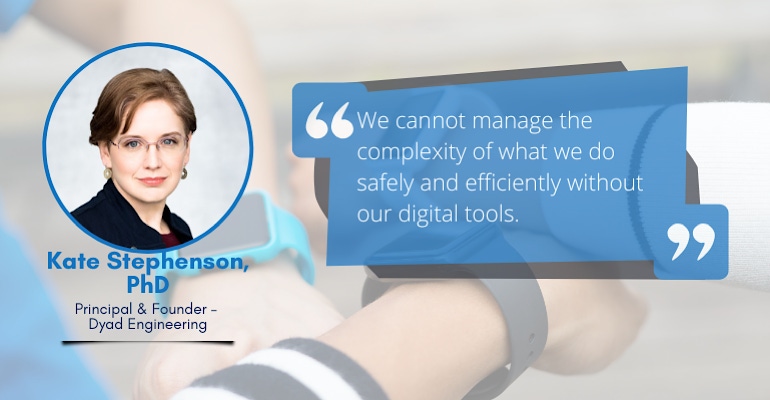Software tools are essential for the medical device industry. But are these tools being crafted with the industry in mind?
April 26, 2023

Whether using a computer to draft, engineer or manufacture (CAD/CAE/CAM), analyze and simulate, or simply managing the endless documentation and details of a product’s lifecycle, specialized industrial software is an integral part of modern medical devices. We cannot manage the complexity of what we do safely and efficiently without our digital tools. However, for anyone who has ever had to struggle with seemingly bizarre menu trees, archaic file formats, or hacked workarounds, it is clear these tools are borrowed, not made, for the medical device industry.
All software, even those industry behemoths with 30-plus years of history, carry the fingerprints of their birth applications deep in their coded bones. The first standalone industrial design platforms of the late 1980s and ‘90s were spun out of the internal development efforts of giants like Boeing and Ford in the US, and Dassault and Siemens in Europe. The technological offspring of that early software still excel at meeting the needs of those earliest customers. Standard CAD packages are great at modeling, analyzing, and documenting solid plastic and metal parts. If you look at simulation products, you’ll find motion and vibration analyses (thank you automotive) along with fluid dynamics and electromagnetic field modeling (aerospace). However, until recently, you would be hard-pressed to find off-the-shelf software that could effectively manage the complex surfaces of a knee joint, the hyper elasticity of a nitinol wire, or the documents unique to a medical device design history file.
This is not to say that medical has not benefited from many of the latest and greatest features of software primarily created for other industries. Cloud Computing and Role Based Access has been a blessing for managing product teams. Gone are the days of running through an office, trying to find out which engineer had left the “current” file open on their computer before heading out to lunch (or vacation). I still shudder at the decade old near miss of a client deleting the master design file of a near complete device. It was saved only though our IT lead driving to the other side of down and recovering it off the backup servers. In a field like medical, which crosses so many different disciplines of business, clinical medicine, and engineering, automating safe access to the design as it progresses is vital.
Can Any Company Fill in the Gaps?
But a function can support medical applications without having been designed and developed for them. Is there a medical equivalent of a Boeing or Ford? Have there been software spinouts from companies that created medical devices so complex, they invented their own software tools? One of the few companies that might be able to claim such is Siemens. The global conglomerate is known in the larger engineering community for its long running design software (SiemensNx, formerly Unigraphics) and Product Life cycle Management (PLM) tools. In the medical world, we know them as the pioneers and makers of highly complex imaging and diagnostic equipment. Like Google’s office products, Siemens suite of life science products likely started as internal tools for their medical device teams that found demand in a subset of their software clients. The software exists due to convenient overlap in customer needs across the expertise of multiple corporate verticals.
Finding the Right Fit

To find software companies (not medical manufacturers) focused on the needs of medical manufacturers, you need to find a niche unique to our industry that is also valuable enough to demand profitable licensing fees. Knowing this, it should surprise no one that the longest running software tools in medical are not for design work directly but to manage the federally mandated documentation of those designs. Quality Management System (QMS) software incumbent MasterControl has been around since 1992, Intellect was started immediately after the Silicon Valley dot-com crash and even the small business friendly “newcomer” GreenlightGuru is a decade old. These products have evolved beyond simple “vaults” for completed master records to templatized and automated design history files that streamline the journey from concept to regulatory submission and on through the life of the product. As medical devices continue to evolve into new forms (software as medical device, personalized devices, combination devices) and new technology is implemented (AI/ML, cell-based products, auto-generated design) new niche products in this space will continue to appear.
When it comes to design software that can manage the complex topography (aka lumpiness) of human anatomy, it took the invention of a whole new class of medical devices to justify that development. The best off the shelf solutions for editing clinical imaging files into engineering models are all owned and developed by 3D printing businesses (Stratasys, 3D Systems and Materialize) and sold primarily to hospitals for patient anatomy models. As medical grade on-site manufacturing resources continue to develop for different clinical niches, application specific design software (like Rodin4 Neo for orthopedic bracing or CEREC for dental application) are being developed to encourage the purchase of expensive production equipment. These product tools are being developed because they support other profitable income streams (whether in equipment or via medical billing), rather than generating revenue via software licensing alone.
Meeting Medical Design Challenges Head-on
I’ve seen product design tools evolve over the last 20 years to address almost every generic design and engineering pain point. However, there are plenty of unmet medical design challenges that remain. Almost every major design software has “wizards” that optimize mechanical properties or highlight potential manufacturing issues. Where is the “sterilization wizard”, the software that will help determine how radiation will affect your part mechanics or determine the ideal packaging layout to minimize the amount of EtO needed? We can model non-newtonian fluids and cow aerodynamics, why can we not simulate how a catheter will perform after sitting on a shelf for two years? There are now a dozen software platforms that can precisely extract the geometry of a patient’s heart, but how do we create Big Data-driven anatomy models that check a new design against the an entire population?
These applications all have deep technical challenges, but it will be the funding model (whether leveraging pre-existing work, addressing emerging liabilities or enabling new profit) that will determine when and how they will arrive in our toolbox.
About the Author(s)
You May Also Like




